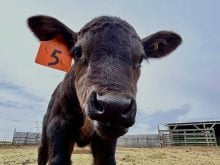Now is the time to do a good inventory of feed sources and whether there is enough for a long, cold winter.
I always recommend to be on the lookout for alternative feed sources, as one never knows when you could run short. Feeds ranging from distillers grains to cull potatoes are among alternative sources. One just needs to figure out how they fit into your program with the maximum benefit.
Feed quality is different every year, so a feed test is always a great idea to make sure protein and energy are where you want them. Reducing herd size by culling for open cows, or those with bad feet or poor temperament, allows you save more feed.
Read Also

Harvest wraps up and fall work begins
At the Eppich famly ranch in western Saskatchewan, the fall harvest was successful with few breakdowns, cows and calves have been sorted and a new tractor has arrived
Having your veterinarian pregnancy check the herd, whether by ultrasound or normal rectal exam, can identify open cows and those with later conceptions.
If there are very few open cows, perhaps the later bred cows will be next in line for culling as they will often come up open the following year. Those later calves will also be smaller this year simply because of their calving date.
Preg-check time is also time for other management procedures such as vaccines and control of parasites. Any open cows or others to be shipped should not be treated, which saves cost and avoids the required withdrawal times.
Preg-checking is also a great time to do a rough body condition score. First, determine the average body condition score. You want it at 3.0 to 3.5 on a five-point scale. The thinner cows need to be identified in case they need to be fed more and given time to catch them up in body condition before it gets too cold. You will find that many of the thin ones will be open. Whether it is age, just poor doing, milking extremely heavy or having some concurrent illness, the thin cattle in your herd are telling you something. If thin cows appear diarrheic, that could indicate Johne’s disease. A manure sample should be sent for a diagnosis.
If kidney infection is suspected, your veterinarian can spend more time palpating for enlarged kidneys or ureters. If possible, obtain a urine sample. Some thin cattle can be treated to success while others continue to go down hill.
Testing is recommended
Cows with early Johne’s disease or early kidney infection can be shipped, provided they aren’t too thin. With these culling decisions it is far better to act as soon as possible. If treatment has started, make sure you recognize the medication withdrawal time.
If Johne’s disease is suspected, it may be best to test most of the cows in poorer condition, as this is often one of the first signs. If diagnosed, your veterinarian can help develop a strategy to test cohorts or female offspring in the herd to get a good handle on whether Johne’s shedders are present. From there, a strategy can be developed to eliminate positive animals and keep further incidence down.
Inspect cows with bad feet. They may need to be culled, or perhaps a simple foot trim may get you a few more years on a productive cow.
Identify the thinner bred cows you are keeping and run them with the bred heifers. This allows them to catch up in condition without the pecking order issues experienced in the main herd.
Again, if you have too many thinner cows, explore the reason for each. The kidney infections in older, heavier pregnant cows may be just a fluke so generally not an issue.
Keeping too many cows with poor udder and teat conformation can lead to cases of chronic mastitis. If cows develop huge teats, they may not get sucked, leading to mastitis.
Go slowly
Introduce new feed to the herd slowly over a few days. Producers should always have on hand products that treat digestive disorders. That includes a product for bloat often called anti-gas, which for frothy bloat works quickly and effectively. Also the possibility of grain overload — known as carbohydrate engorgement — can occur anytime there is a sudden feed change or in situations where cattle somehow break into a grain bin or some grain source.
Cattle can have diarrhea and a staggery walk from weakness much like an acidotic calf with scours walks. For both the aforementioned conditions, have enough product to treat several head as these often occur with multiple animals affected.
Something to keep in mind for next year: Even temporary fencing of marginal brushy land or grain fields can help to graze later in the year and extend season. A water source needs to be available, but even if grazing harvested grain land there may be enough sloughs and low spots. A water line can be run through culverts and go to a water trough if the weather is mild enough.
Winter leads into spring and calving time so it doesn’t hurt to get calving supplies early, as we never know when supplies will run short. It is the world we live in unfortunately, but the craziest things have been unavailable, including things such as RFID tags, regular tags and scour vaccines, so one never knows when something you critically need runs out.
Let’s hope for a milder winter so weight is much easier to keep on our cattle and we can save a bit on bedding.














